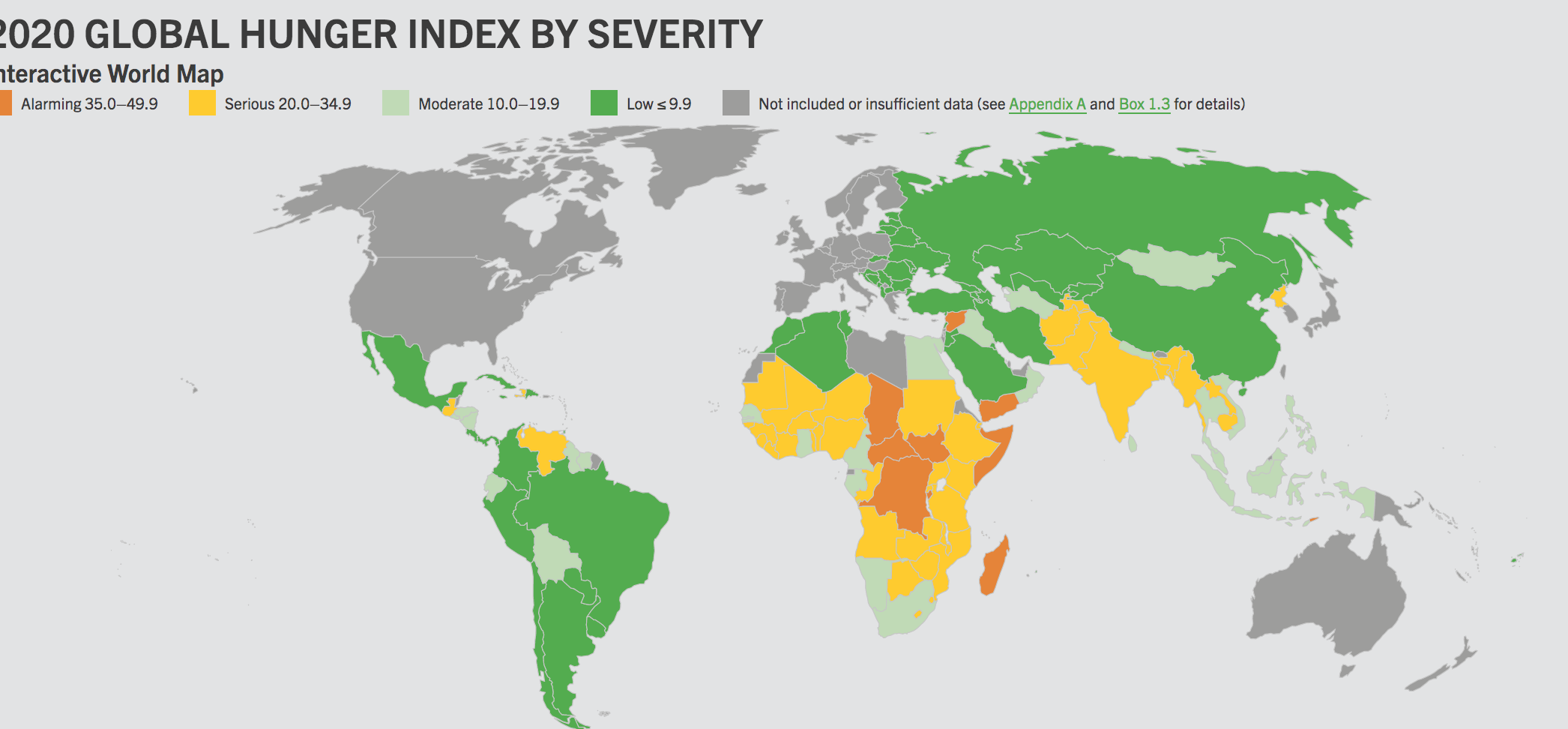Overall, the world has made gradual progress toward eliminating hunger over the last two decades, but according to the latest Global Hunger Index published Monday, progress is far too slow – so much so, 37 countries won’t even reach low levels, much less zero, hunger by 2030.
The Global Health Index (GHI), published every year since 2006, assigns every country a score from 0 (no hunger) to 100 based on the country’s rate of undernourishment, child wasting (low weight-for-height), child stunting (low height-for-age) and child mortality.
GHI scores of 50 and above are considered “extremely alarming” – thankfully, no country scored that high this year. But eleven countries have “alarming” levels of hunger. Those include Chad, Timor-Leste, Madagascar, as well as Burundi, Central African Republic, Comoros, Democratic Republic of Congo, Somalia, South Sudan, Syria and Yemen – although the latter eight countries lack sufficient data for a definitive GHI score. Forty countries registered “serious” levels of hunger this year, while 26 scored in the “moderate” range.

The good news is that 48 countries have low levels of hunger (GHI scores of 9.9 or less). Seventeen countries even received scores of less than 5, including Brazil, China, Cuba, Kuwait, Romania, Turkey and Ukraine. And 46 of the countries in the moderate, serious or alarming categories have improved their scores since 2012. Globally, hunger worldwide has declined since 2000 from serious levels (GHI score of 28.2) to moderate (18.2).
As always, averages can hide inequalities, and the report notes that even though some countries don’t have national hunger crises, certain regions and marginalized groups within those countries still face “tragically high levels of hunger and undernutrition.” Additionally, 14 countries in the moderate, serious or alarming categories have actually gotten worse. Globally, nearly 690 million people are still undernourished, and in 2018, 5.3 million children died from undernutrition before their fifth birthday.
COVID Not Included
However, these scores and figures do not account for the impact that current crises – including the COVID-19 pandemic and economic recession, desert locust outbreaks and environmental disasters – will have on hunger, especially in the countries and communities that are already struggling with severe food insecurity and undernutrition.
“The events of 2020 are laying bare many of the vulnerabilities of the world’s food system in ways that are becoming impossible to ignore,” the report’s guest authors wrote in an accompanying essay. “It was already clear that it would be a struggle to eliminate hunger within the next decade under the current food system. Now we know this system is woefully inadequate for coping with the kinds of overlapping global and regional crises that we are currently experiencing and may expect more of by 2030.”
Some of the solutions recommended by the report’s authors include more support for smallholder farmers to become “sustainable and diversified producers;” classifying the production and supply of food as essential services, holding major actors in food systems legally accountable for upholding human rights and protecting the environment; building up social protection systems, including universal health coverage, social security, cash and voucher assistance; and making global food trade policies more equitable for low- and middle-income countries.
It’s a complex problem that has to be tackled on multiple fronts, but a recent project from Cornell University believes that it can help simplify the solutions for policymakers.
The project, Ceres2030, used artificial intelligence to sift through more than 500,000 scientific research articles in order to find the best solutions for eradicating world hunger. The results were published on Monday as 10 new research papers. The researchers behind the project believe that with solutions, like smallholder farmers adopting climate-resilient crops – zero hunger is possible.
At the very least, the GHI report says that “dramatic progress is possible,” as demonstrated by the trends the index has tracked over the last two decades. In Angola, Ethiopia and Sierra Leone, for example, hunger has fallen two category-levels, from “extremely alarming” in 2000 – when the countries were seized by civil wars and their aftermaths – to “serious” in 2020. At the same time, hunger levels in Cameroon dropped from “alarming” “moderate,” as the country “doubled its per capita GDP and boosted its human development indicators.”
“At this crucial moment, we must act to reshape our food systems as fair, healthy, and environmentally friendly…” the report’s guest authors wrote. “…By taking an integrated approach to health and food and nutrition security, it is possible to achieve Zero Hunger by 2030.”
